The 1960s ushered in the beginning of the death knell for the Hollywood Western Movie. You had to blame TV really.
In the UK we only had two channels in 1960 but both were awash with the likes of Wagon Train, Bronco, Cheyenne, Sugarfoot, Rawhide, Bonanza, The Lone Ranger, Laramie, The Range Rider, Boots and Saddles – the list goes on forever.
Hollywood had to up its game to beat the threat of television but in the end, it was a one-sided battle, and by the end of the decade, the days of the Hollywood cowboy genre were well and truly numbered.
Of course, I didn’t know that at the time. I just tried to catch every Western going from the age of eight onwards, so here’s another trip down memory lane as I review ten of the most memorable horse operas I saw in the 1960s.
Before I start, for those of you looking for reviews of any of the Sergio Leone Dollar trilogy movies, I’m keeping my powder dry on that subject for a future article on the Westerns of Clint Eastwood.
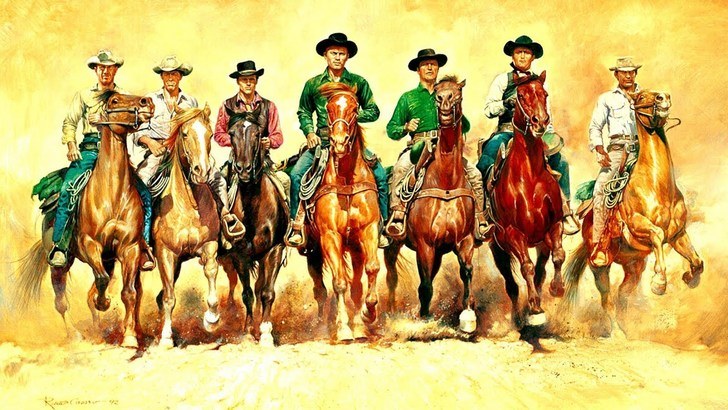
The Magnificent 7 (1960)
What a great start to the decade. One of the most popular cowboy films ever made – and not one pesky Injun in sight.
As we all know, it’s a remake of Kurosawa’s Seven Samurai, transplanted from medieval Japan to bandit-ridden Mexico.
Yul Brynner is ostensibly the main star but the film belongs of course to the likes of Steve McQueen, James Coburn and Charles Bronson who, along with Robert Vaughan, Brad Dexter (the one no one can ever remember) and Horst Bucholz, plus Eli Wallach as the dastardly Mexican bandit leader, Calvera, collectively make this one of the best casts ever assembled for a Western film.
I won’t go through the plot here as, if you haven’t seen it yet, then I suggest you go and stream / steal / beg / borrow the film from the nearest available outlet and sit down for two hours and eight minutes of pure unadulterated cowboy action, helped of course by the famous soundtrack composed by Elmer Bernstein.
The music is practically the eighth member of the Magnificent 7, something Bernstein pointed out himself when I saw him in concert in London back in the early 2000s.
He told the audience that the rough cut of the film was a bit slow, pointing specifically to one scene in which the Mag 7 meander past a big tree on their horses as if out for a Sunday afternoon picnic. Bernstein decided the film needed a score that would inject some energy and urgency into scenes such as this and came up with what is now probably the best-known Western soundtrack of all time.
The final gunfight between the seven and Calvera’s band is probably the most memorable sequence in the film but the one that stayed with me as a child was the face-off between the luckless Robert J. Wilke and James Coburn, who turns out to be an expert knife-thrower.
Another case of instantaneous death Hollywood-style but Coburn is so imperturbable in that scene he gives Steve McQueen a real run for his money in the “who’s the coolest dude?” stakes.
Talking of McQueen, I read in one of his biographies that the producers of the TV series he was starring in at the time, Wanted – Dead or Alive, wouldn’t give him time out to appear in the film.
He got around this by crashing his car and then faking an injury so that he could take the role of gunfighter Vin Tanner, which basically made him a star. Now that’s cool.
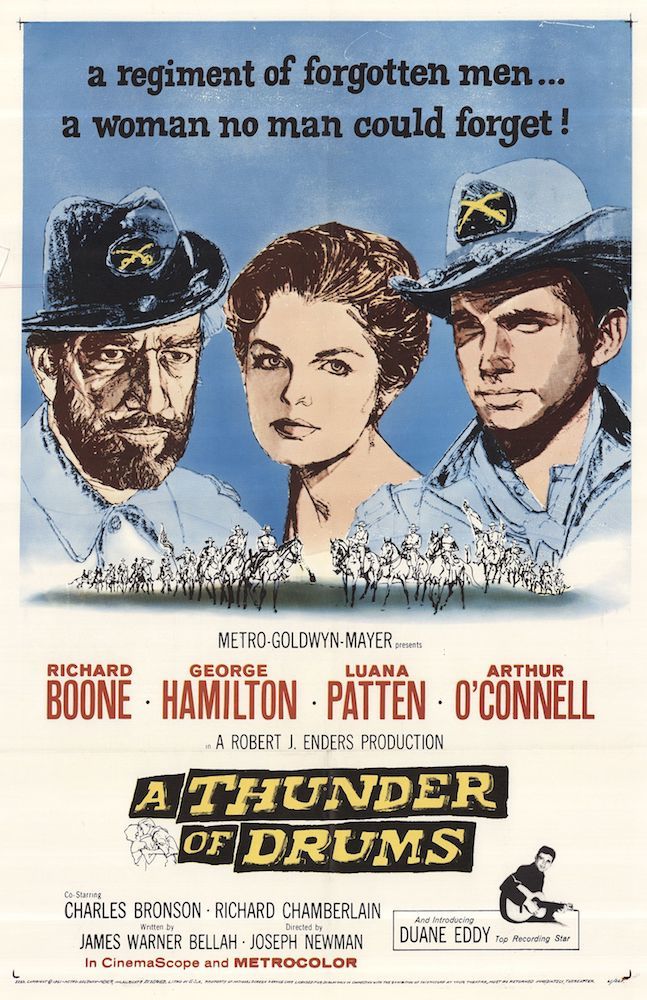
A Thunder of Drums (1961)
I mentioned this film in a previous article on the double bill programs I saw in the 1960s. The other movie on the bill, The Colossus of Rhodes, directed by none other than Sergio Leone (not his directing debut as I mistakenly asserted in that article) was a sword and sandal strong-man peplum mini-epic that I found far more entertaining as a young boy back in 1961.
I have to thank TCM for affording me the opportunity to reconsider my earlier perfunctory dismissal of A Thunder of Drums as it seems to turn up in their schedule at least once a month these days.
What I obviously didn’t realise when I first saw it all those years ago is that it’s what they probably called an ‘adult’ film back then.
The orange perma-tanned George Hamilton, an actor so wooden he positively creaks as he walks, is told by his girlfriend that she nearly – nearly? – became pregnant by him.
Hamilton, as a typically green around the ears cavalry Lieutenant – the kind they used to ‘frag’ in Vietnam – clashes with his commanding officer, played by Richard Boone, who gives probably the best performance in the film. Not that he had much competition, considering Duane ‘Guitar Man’ Eddy is in the supporting cast.
There isn’t that much action in the film to speak of, which is probably why I preferred The Colossus of Rhodes at the time, but it stands up well when viewing it again in later years.
The one scene I do remember from when I saw it all those years ago is towards the end when Boone and Hamilton go off in search of a cavalry troop that has gone out on patrol and not returned.
Boone detects the smell of rotting bodies which eventually leads him to the site of the massacred troops, the camera dwelling for just a few seconds on the horrific carnage inflicted on the men by Apache warriors.
There’s one surprise at the end of the film that I hadn’t noticed until I watched it again recently.
Hamilton’s character apologises to Boone for his previously inept behaviour, prompting Boone to reflect that his predecessor at the fort used to have a saying. ‘Never apologise, it’s a sign of weakness’.
I checked and sure enough, the script for this film is by James Warner Bellah, who also wrote the original source material upon which She Wore a Yellow Ribbon was partly based. So there it is. A Thunder of Drums is an unofficial sequel to She Wore a Yellow Ribbon.
You learn something new every day.
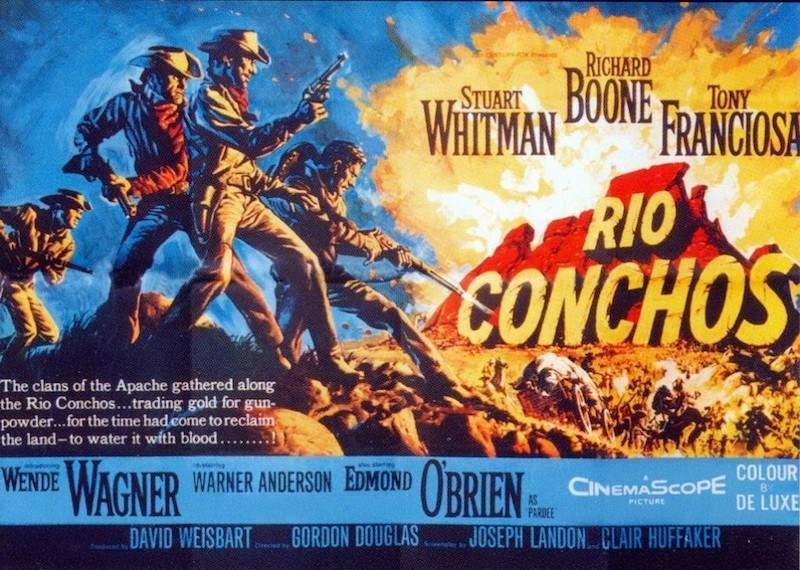
Rio Conchos (1964)
Another Richard Boone vehicle, Rio Conchos was a very popular film at the time for a number of reasons.
First of all was the casting of professional American football player, Jim Brown, who I believe was still playing the sport at the time he made the film.
Brown attracted a lot of attention because he wasn’t in the same mould of someone like Sidney Poitier, who up to that point was the go-to guy when it came to African American actors.
Also, tame as it might seem by today’s standards, there’s a stunt involving Brown, Richard Boone and Stuart Whitman in which they – or their stand-ins – are tortured by being dragged behind a speeding a wagon.
It was thought to be so impressive that I remember one of the major daily newspapers running a spread specifically on the stunt sequence.
There are some similarities between Rio Conchos and the earlier John Wayne vehicle, The Comancheros, probably due to Clair Huffaker co-scripting both films.
For example, Nehemiah Persoff in The Comancheros and Edmond O’Brien in Rio Conchos are both heading up secretive communities that operate outside the law, in O’Brien’s case a bunch of ex-Confederate soldier’s intent on making the South great again by selling rifles to the Apaches. And Stuart Whitman is in both films as well.
It’s a real high, wide and handsome Twentieth Century Fox Cinemascope production that features great performances from all the principals, most notably Boone (of course), as an embittered ex-officer out to avenge the death of his family at the hands of the Apaches.
Stuart Whitman is reliably granite-jawed as the army captain leading Boone, Brown and Tony Franciosa, who plays a Mexican knife-throwing scoundrel, in pursuit of O’Brien’s lawless Confederate organisation.
There’s one other thing Rio Conchos has in common with certain other Westerns that I noticed when watching it a while back. I call it the ‘Laughing Mexican Stand-Off’ sequence, which has featured in quite a few movies over the years, from Treasure of the Sierra Madre through to The Wild Bunch.
It invariably features a giggling Mexican Bandido, or a gaggle of giggling Mexican Bandidos, attempting to trick a foolish gringo, or occasionally a gaggle of foolish gringos, into thinking that they mean them no harm.
They always, without fail, communicate this through the medium of laughter, grinning and chortling out of context, engaging in banter and cracking jokes whilst all the time trying to figure out when it might be convenient to draw their guns and slaughter the gringos where they stand.
And they always, without fail, get it wrong. Every single time. Luckily for Boone and the boys they’ve got their very own giggling Mexican in Tony Franciosa, who helps despatch a couple of laughing bandits via the application of a very large kitchen knife.
A thoroughly entertaining widescreen Western, directed by Gordon Douglas, that every discerning cowboy film fan should be familiar with.
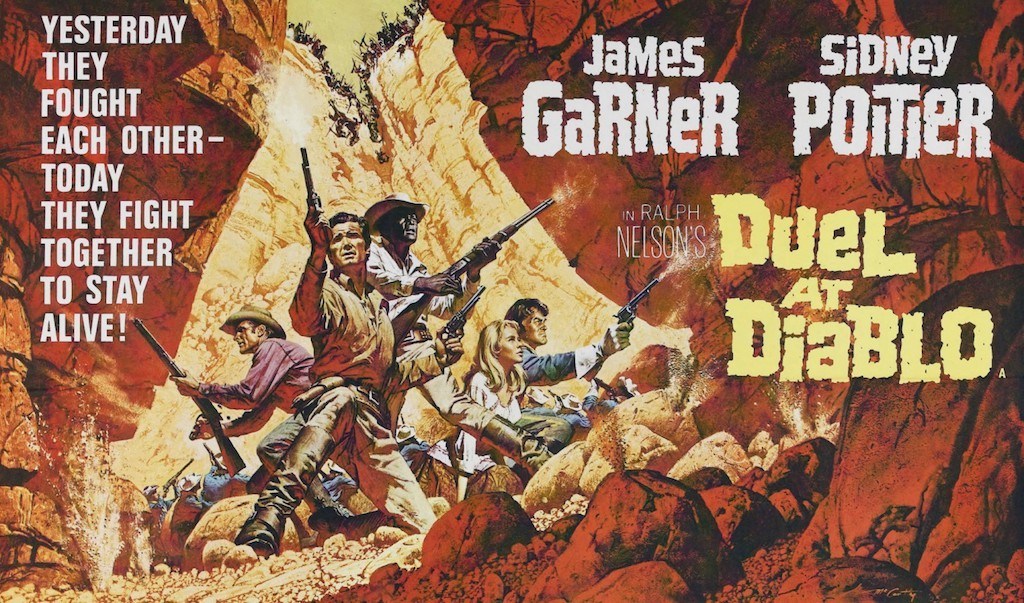
Duel at Diablo (1966)
Directed by Ralph Nelson, who went on to direct the infamous Soldier Blue four years later, this has what I can only describe as an interesting supporting cast.
Leaving aside Sidney Poitier for the moment, it’s a bit difficult to understand what English actor Bill Travers and Swedish actress Bibi Andersson are doing in the film. Anyone could have played their roles. Maybe they were on holiday.
Poitier’s presence is a different kettle of fish. I haven’t seen this movie in quite a while but if I recall correctly, the colour of his skin does not figure at all in terms of the story.
He’s a retired soldier slash gunfighter who just happens to be black, which is kind of refreshing in an era when African American actors in mainstream movies such as this were thin on the ground, and when a black actor did figure in the cast it was more of a token gesture than anything else.
It’s James Garner’s turn to play yet another of those ‘cowboy seeks vengeance for the death of their wife’ roles, a part that Randolph Scott played almost to the hilt in quite a few of his Westerns.
Garner, as scout Jeff Remsberg, rescues Bibi Andersson from a bunch of marauding Apaches and takes her back to her husband, played by Dennis Weaver, that nice Chester from Gunsmoke, or McCloud if you prefer.
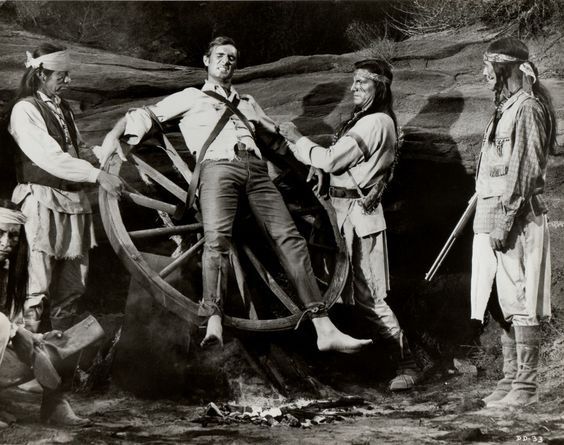
This kicks off a whole world of brown stuff involving rape, torture by fire, miscegenation, violent death, you name it this film has it.
I’m guessing I must have seen the movie with one of my parents because the graphic violence, graphic for the mid-1960s anyway, makes me think it must have had an adult certificate, otherwise I’d never have been allowed to get into the cinema to watch it on my own.
The title of the movie refers to the climax of the film in which Garner, Poitier, Bibi, Bill and Dennis end up under siege in Diablo Canyon by Apache warriors.
Garner manages to ride off and get help from a nearby army fort where he learns that Dennis was the one who killed his Comanche wife.
Returning to rescue the others he finds McCloud / Chester / Dennis barely alive, tied upside down on a wagon wheel after the Apaches kidnapped and tortured him with fire.
Dennis pleads with Garner to shoot him but Garner gives him a gun instead so that he can blow his own brains out. Which he does. Then everyone lives happily ever after, except Bill, who gets killed by the Apaches during the siege.
I liked this film a lot. In fact, I even bought the poster.
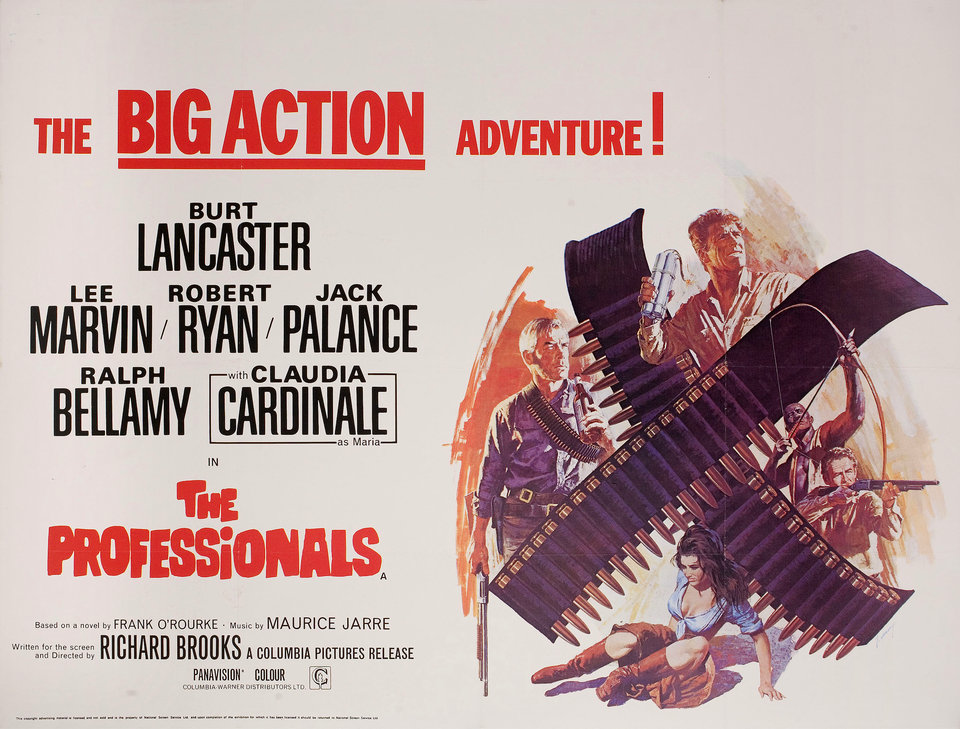
The Professionals (1966)
The Magnificent 7 was the first of a number of films released in the 1960s that featured a team of hired hands each specialising in a certain skill. James Coburn was good with a knife and the other six were all good with their guns, so a bit thin on the ground there to be honest in terms of individual skill sets, but I’m sure you get my drift.
The Professionals offer more choice in the deadly expertise stakes, with all of the main cast members specialising in their own lethal skill.
A Mexican Bandido, played by Jack Palance, kidnaps the beautiful wife, played by Claudia Cardinale, of a rich old man.
The rich old man subsequently hires a bunch of mercenaries to rescue and bring Claudia back to his rich old arms.
The hired professionals comprise Burt Lancaster as an explosives expert, Lee Marvin as a weapons specialist, Robert Ryan as a horse wrangler and Woody Strode as an expert killer with a bow and arrow.
Seeing as the twist is that Claudia wasn’t actually kidnapped but went quite willingly with Jack, we can only surmise that Palance’s area of expertise is wooing the ladies.
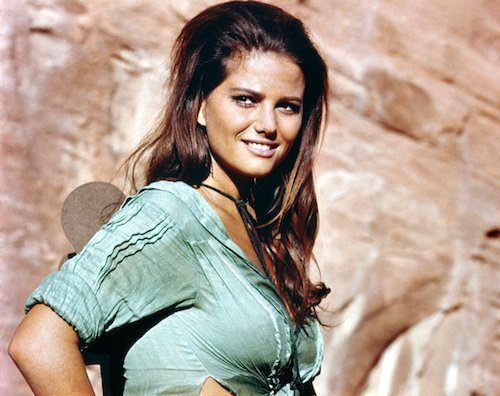
This is admittedly a bit of a stretch considering he looks like he’s been whacked in the face with a very heavy frying pan, whilst Claudia’s main talent is to just look absolutely stunning, which of course she manages to do quite magnificently in every single frame she graces.
As they’re professionals, the mercenaries decide to honour the agreement with the rich old man, and re-kidnap Claudia, hot-footing it back to a train they have previously liberated from Jack’s gang.
What’s left of Jack and the gang follow in quick pursuit. The good guys find the train has been retaken – I hope someone’s taking notes at the back there – so they ride off into the mountains, each one using their specific skills to delay the Bandidos via the indiscriminate application of explosives, guns, arrows etc etc., before eventually returning Claudia to her old man.
They throw in a bonus by capturing Palance and giving him to the old guy as well.
The more I think about this film, the more it comes to resemble The Wild Bunch, which I’ll be reviewing later.
The end of The Professionals in particular pre-echoes the end of Peckinpah’s film in that a band of reprobates reveal a hitherto unknown streak of morality that makes them do the right thing, even though, in the case of The Wild Bunch, they may die in the process.
In this instance, Marvin and the others help to reunite the lovelorn Jack and Claudia, sending them back to Mexico against the wishes of the rich old man.
It kind of makes everything else that has gone before somewhat redundant but as they say, it’s all about the journey rather than the destination.
It’s a very professional film – pun intended – and definitely worth seeing if you’ve not caught it before.
Part 2 of the Best Westerns of my childhood.

Robert Vaughan`s autobiogaphy , which is 1 of the best i have ever read gives a very interesting insight to behind the scenes at Mag 7, including McQueen`s insecurities and his complaining that yul brynners gun had a pearl handle and his did`nt ….by the way great great article really enjoyed it …please keep them coming !!
Thank you so much for your kind words. To paraphrase Bo ‘Crazy Lee’ Hopkins in The Wild Bunch, “I’ll keep writing these articles ’til Hell freezes over or you say different”